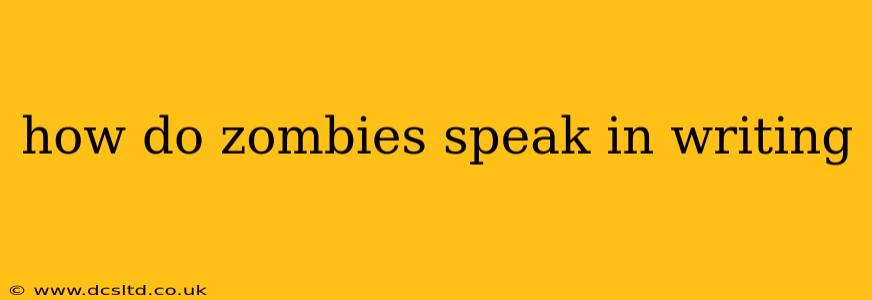Zombies. The shambling, groaning, flesh-eating undead have captivated audiences for decades. But how do you capture their unique, decaying vocalizations on the written page? It's more than just "braaains!" It's about creating a chillingly effective representation of their deteriorated communication. This guide will explore various techniques to bring the zombie voice to life (or rather, un-life) in your writing.
What Makes Zombie Speech Unique?
Before diving into techniques, let's consider what sets zombie speech apart. It's not just about grammar; it's about the sound and the meaning (or lack thereof). Think about their physical state: decaying vocal cords, damaged brains, and a primal, instinctual drive. These factors drastically alter their ability to communicate effectively.
Techniques for Writing Zombie Dialogue:
1. Broken Grammar and Sentence Structure:
Zombies aren't known for their eloquence. Their speech often reflects their deteriorated mental state. Use fragmented sentences, missing words, and incorrect grammar to convey their limited cognitive function.
- Example: "Braaains...must...eat...braaains..."
2. Repetitive Phrases and Sounds:
Repetition emphasizes their single-minded obsession, often with the need to consume brains. Repeating key words or sounds reinforces their primal nature and lack of complex thought.
- Example: "Grr...flesh...grr...hungry...flesh..."
3. Grunts, Groans, and Gurgles:
Don't forget the non-verbal elements! Integrate onomatopoeia to represent the guttural sounds zombies make. These sounds add texture and realism to their dialogue, enhancing the overall atmosphere of horror and decay.
- Example: "Rooooaargh...gurgling...braaaains..."
4. Mimicking Decomposition:
Consider how the physical decay of their vocal cords might influence their speech. Perhaps their words are slurred, raspy, or barely audible. This adds a layer of realism and disgust.
- Example: "Rasp...need...wheeze...braaains..."
5. Echoing Past Personalities (Optional):
In some zombie narratives, hints of the person's former self might bleed through their corrupted speech. A few well-placed words or phrases can subtly hint at their previous life, adding layers of complexity and pathos.
- Example: "Braaains...a faint whisper of a name...must...eat..."
How to Balance Horror and Readability:
While creating a realistic zombie voice is crucial, ensure your writing remains accessible to readers. Overuse of broken grammar or unintelligible sounds can quickly become frustrating. Find a balance: use these techniques strategically to create a chilling effect without sacrificing clarity.
What types of zombies are there?
The portrayal of zombies varies widely in fiction. Some are fast, others slow; some retain intelligence, while others are purely instinctual. The type of zombie you are portraying will influence how you write their dialogue. A highly intelligent zombie might use more complex sentences than a purely instinctual one.
How can I make my zombie dialogue scarier?
The scariest zombie dialogue often comes from the unexpected. A zombie uttering a coherent sentence from its past life can be far more unsettling than simple groans and growls. Use unexpected clarity or hints of the former personality to maximize the fear factor.
How do I make sure my zombie dialogue is believable?
Believing zombie dialogue relies on consistency. Establish a pattern of speech early on and stick to it throughout your story. Remember the physical limitations of the undead and let that inform their communication. It should be authentic to the zombie type you've created.
By mastering these techniques, you can craft chillingly effective zombie dialogue that enhances your story's horror and suspense while maintaining readability. Remember, the goal isn't just to mimic the sounds of the undead, but to capture their essence and their terrifying impact on the living.
